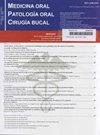Accuracy in osteotomy drilling using a new universal and disposable drill-stop device for dental implant drills: an in vitro study using a bovine rib model.
IF 2.1
3区 医学
引用次数: 0
Abstract
BACKGROUND This study aimed to evaluate the surgical accuracy of a new universal disposable stop system for implant drills (FCA Universal Drill Stop). MATERIAL AND METHODS A total of 60 bovine ribs were included in this in vitro study. The ribs were randomized into three study groups (n=20 ribs per group). In each study group (Group1: drills without stop or control group, Group 2: prefabricated drills with stop or gold standard group, and Group 3: drills with FCA Universal Drill Stop) a total of 100 osteotomies were performed with implant drills in each group, following the drilling sequence for the placement of a dental implant of 10 mm length and 4 mm diameter. The accuracy of the depth of the osteotomies was quantified clinically (with periodontal probe) and radiologically, using ImageJ version 1.48v software. RESULTS The order of highest to lowest accuracy (clinical and radiological) in the depth of osteotomies was: FCA Universal Drill Stop> prefabricated drills with a stop>drills without stop, with statistically significant differences being observed between both systems with stop with respect to the control group, although not between them. CONCLUSIONS The new universal disposable stop system for implant drills, offers similar accuracy to prefabricated drills with stop, with both systems being much more accurate than implant drills without stop. Although this experimental evaluation showed favourable results, further clinical studies are necessary.使用新型通用一次性牙科种植钻钻头止钻装置进行截骨钻孔的准确性:使用牛肋骨模型进行的体外研究。
背景本研究旨在评估用于种植钻的新型一次性通用止钻系统(FCA 通用止钻器)的手术准确性。这些肋骨被随机分为三个研究组(每组 20 根肋骨)。每个研究组(第一组:不带止动器的钻头或对照组;第二组:带止动器的预制钻头或金标准组;第三组:带 FCA 通用钻头止动器的钻头)都使用种植钻头进行了总共 100 次截骨,按照钻孔顺序植入了长度为 10 毫米、直径为 4 毫米的种植体。结果截骨深度的准确性(临床和放射学)从高到低的顺序为:FCA通用钻止器>首选钻止器>FCA通用钻止器:结论新型一次性通用种植体钻止动环系统的准确性与带止动环的预制钻相似,两种系统的准确性都远高于不带止动环的种植体钻。尽管实验评估结果良好,但仍有必要开展进一步的临床研究。
本文章由计算机程序翻译,如有差异,请以英文原文为准。
求助全文
约1分钟内获得全文
求助全文
来源期刊

Medicina oral, patologia oral y cirugia bucal
Medicine-Surgery
CiteScore
4.50
自引率
0.00%
发文量
52
期刊介绍:
1. Oral Medicine and Pathology:
Clinicopathological as well as medical or surgical management aspects of
diseases affecting oral mucosa, salivary glands, maxillary bones, as well as
orofacial neurological disorders, and systemic conditions with an impact on
the oral cavity.
2. Oral Surgery:
Surgical management aspects of diseases affecting oral mucosa, salivary glands,
maxillary bones, teeth, implants, oral surgical procedures. Surgical management
of diseases affecting head and neck areas.
3. Medically compromised patients in Dentistry:
Articles discussing medical problems in Odontology will also be included, with
a special focus on the clinico-odontological management of medically compromised patients, and considerations regarding high-risk or disabled patients.
4. Implantology
5. Periodontology
 求助内容:
求助内容: 应助结果提醒方式:
应助结果提醒方式:


